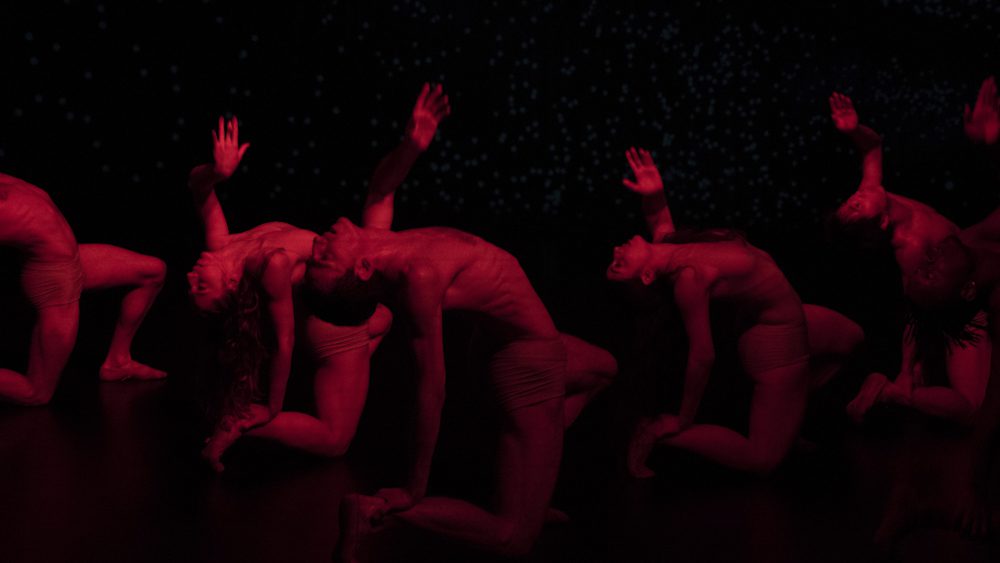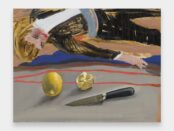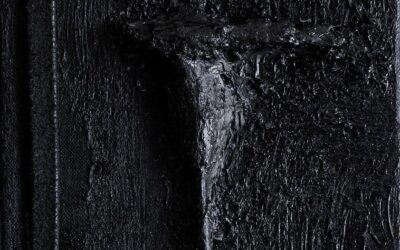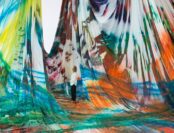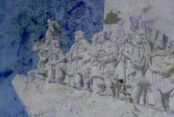For many, the art of Amsterdam is synonymous with Van Gogh and the Dutch masters, less so for anything more contemporary (or to be generous, anything more recent than Piet Mondrian). Sensing a change in priorities, the aim of Amsterdam Art week is not to challenge the past but to create pathways into the unexpected side of this picturesque, but immensely livable, city. And in the process, to uncover a surprising penchant for reinvention.
For Amsterdam Art Week 2024 (29th May – 2nd June and scheduled for 2025 for 21-25 May), the city extended the expected; established galleries showcased local-inflected works, including challenging student pieces. Angles ranged from arch political comment to cultural boat tours along historical canals and, of course, boutique hotels displaying rare works from their often shuttered private collections. But in our globalised world, what is it about Amsterdam art week that makes it something specific to Amsterdam?

Director Martina Halsema places the event within the city’s centuries-long tradition of multicultural sanctuary;
“We are a cosmopolitan city on a small scale, very charming, but with top international talent. Amsterdam has a history as a breeding ground where talented, emerging artists from all over the world can flourish and therefore the perfect place of discovery. Amsterdam Art Week is the pivotal moment on the contemporary art agenda, where the city hits its artistic peak. It marks the best moment to dive into a whirlwind of cutting-edge exhibitions and events as art institutions unveil their finest talent to a global audience”.
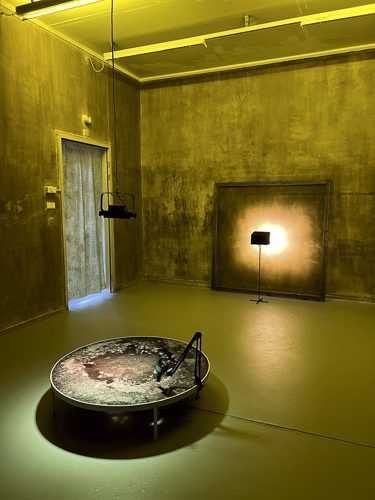
The Rijksakademie van Beeldende Kunsten (founded 1870) has a reputation as a proving ground for career artists and from the almost 1200 applicants the academy assesses for their two-year residency programme, only 50 are chosen. Visiting the studios, open for the festival, is a glimpse into the petri dish of international art’s future. The vigour is real, and it was refreshing to see painting being reworked within multi-material practices; bioactive ‘paint’ being treated with light sources to react, grow and decay (Maksud Ali Mondal), used in performances, or applied as a pastiche of manufacturing process (Benjamin Li).
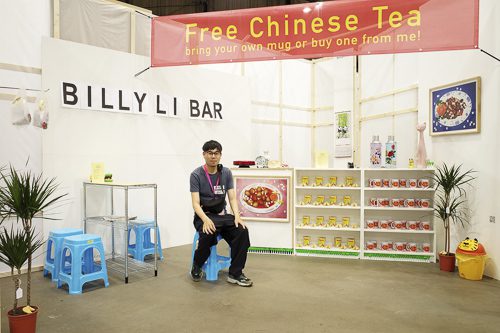
Along with video art, the use of different materials as a foundation for political sentiments conveyed through conceptual works was a thread running through the academy’s current weave. Ecological, social and cultural identity, solidarity with Palestine — the unreserved passion of young artists is a connective tissue to the inspirational heart where, for many of us, art started.
Journeying into the city centre to visit some of the galleries showing work was no less exciting. Finding hip galleries nestled amongst 17th-century townhouses, divided and united by busy canals, gives the viewer a borrowed sense of insider savvy. Artificial street smarts, if you like, but an enjoyable edge in a city where around every corner is some cultural or novel treasure. Visiting a city during an artweek gives you a different lens to see a place. It enriches tourist attractions, such as a venerable cheese shop amongst grander architecture, by juxtaposition. Rushing around to see it all creates —by design — a dreamlike drift of the senses where craft, media, and artistry are read together with a pungent significance. (Particularly pungent in the matter of cheese.)
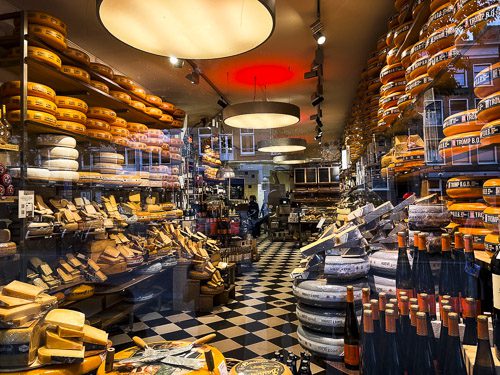
Amid the comfortable urban bustle of Amsterdam’s Elandsstraat is gallery Stigter Van Doesberg. For Amsterdam Art Week they held a group show Female Fatigue answering the question ‘has the art world become bored with “female” artists as a topic?’ The work of artists Melissa Gordon, Dina Danish (previously an artist-in-residence at the aforementioned Rijksakademie van Beeldende Kunsten), Peggy Franck and Erika Peucelle, apparently connected by the exhibition’s theme, take different conceptions of the ‘female’ to give a varied view of the question/challenge.
Danish’s work might be the easiest to approach as she uses many of the motifs and materials traditionally associated with the domestic world, whereas Peucelle uses modern forms of representation (social media) to describe the private language women use with close peers. Approaching each artist’s work as interpretative of the internal aspects of some women’s lives reminds us of ways people live outside of the demonstrative social roles that both create and bind us. For these artists, at least, there are no signs of fatigue in the existential pursuit for expression and recognition of what it is to be an individual. What the works actually say as regards to how ‘womanhood’ is created is open to interpretation.
By contrast, Upstream gallery hosted an exhibition of work by Frank Ammerlaan, whose work has a more cosmological perceptual frame. Within abstractions of geometry and science, his work asks ‘Who are we?’. Guardians is his fifth solo show at Upstream, and this one features a noteworthy piece ‘Guardian1’ (2024) featuring multiple squares of lead arranged to create an undulating surface containing a geometric crater. The cold, clinical squares of lead and the hole elicit a strange impulse, an instinctive recoil, almost. The patterns contain the hallmarks of emotive or spiritual gestures, but there is something mathematical and scientific in their execution which makes the investigative gambit follow a path along less human lines — a distance between the heart and where we find ourselves in the universe.

Ammerlaan is a serious artist, but one whose oeuvre belies a certain conservatism (or at least an elevation from the specifically personal into profound, yet distant areas). Refined, compared to the rich passions of students at the Rijksakademie and yet perhaps missing some of the fire the times demand. Such is the nature of personal taste, though, and with a city full of art there’s plenty to stoke the imagination whatever the preference.
Other exhibitions, such as Josse Pyl’s explorations into the physical manipulation of language via stones and plaster at Annet Gelink Gallery, burst with a pop-tinged verve that marks the current generation. While Pyl’s work contains nods to contemporary graffiti carvings and street culture, the view is actually much deeper, referencing Roman times as much as Disney. The gambit of the work is less about the symbols themselves than about the physicality of language as it uses objects to be created. In a verbal sense, these objects are the teeth, tongues, and mouth cavities, but in other contexts Pyl uses a broader sense of language as it intersects with architecture. He makes a case for seeing architectural forms: portals, arches, tiles, and bricks, as vehicles for language in themselves. Walking around the forms, the scale and placement of the sculptural installations creates a fresh sense of being amid language in a tactile way that plays with the human curiosity about communication.
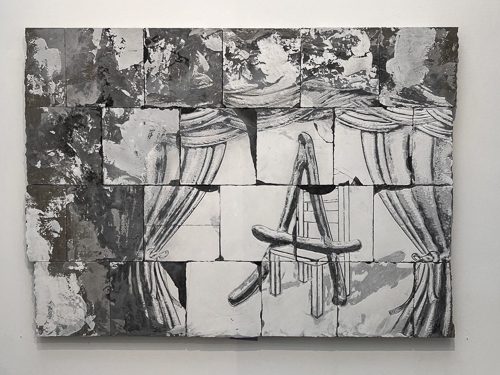
When confronted with an opaque language humans try to understand what the communicator intended and what information they were trying to impart. As a comment on art itself, the exhibition draws focus on art’s ability to communicate. Where the functional aspects of artistic symbols are elevated, by some, beyond the aesthetic; reductively then, art is thus like a pun or misheard whisper. It creates the semblance of import because the listener has to decipher what is said. Whether Pyl’s investigation is reiterating a rhetorical position on art as a ‘do you know what it is yet?’ contrivance is left hanging. Instead, he focuses on ‘how language can imitate and imagine the world around us’ (exhibition notes). In that respect we might find that he considers the opaque imaginative hinterland of meaning the true vehicle for the palimpsest of art and language.
Another complex work was ‘I Wan’na Be Like You’ (2024) by Margit Lukács and Persijn Broersen, at AKINCI gallery. A digital animation showed a ghostly dancing figure moving through a dense jungle and around a derelict Victorian-era greenhouse to Louis Prima’s song from Disney’s Jungle Book (I Wan’na Be Like You, 1967). The denouement shows a Black choir singing a haunting song that touches on the post-colonial themes of the piece.
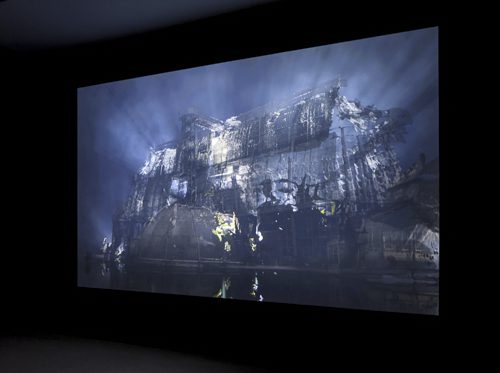
The juxtaposition of colonialism, racism, orientalism and ecology is tough to work through, and the artist’s intention takes some effort to be revealed. A work of this technical and organisational magnitude needs time to digest, and it’s recommended that viewers watch the video a few times to come to grips with the intention, execution and implications.
Along with galleries, a number of hotels with art collections beckon the weary traveller for a final drink surrounded by local and masterworks. The excellent Pillows hotel comes to mind, with fine cocktails attending art travellers as they swap notes on the day’s perambulations before wandering back to their room via art lined walls; a fitting end to long days of canals, cheese, art, cake and contemporary discourse.
Amsterdam Art Week promises a full week’s worth of discoveries, and within a few days the visitor is struck by how committed the city is to supporting art of every level and history. For some, the polish and shine of established artists might draw attention. For others it’s the verve and passion of the student artists that will cast exquisite sights in the mind’s bronze. Regardless, as trite as it sounds, it is the city itself that comes alive during the week. That’s down to people met, connections made, opinions validated and the feeling of camaraderie that comes from a shared purpose — beauty and the pursuit of art.
Amsterdam Art Week, 29th May – 2nd June 202 and 21-25 May 2025. Amsterdam.
amsterdamart.com
AKINCI Gallery
Stigtier Van Doesburg Gallery
Annet Gelink Gallery
Pillows Grand Boutique Hotel
Rijksakademie (Sarphatistraat 470, 1018 GW Amsterdam, Netherlands)
Travel supported by AAW and Pillows Hotel – www.pillowshotels.com/
Cover image: Emio Greco & Pieter C. Scholten, ICK, 2024. © Alwin Poinan

The aim of art is to represent not the outward appearance of things, but their inward significance. – Aristotle

